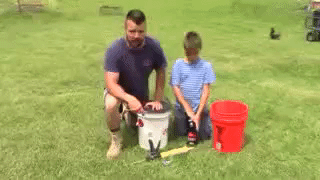3 Composting Bins to Consider for Small Spaces
I got my first composting bin this year and took advantage of my city's rebate program to get some money back into my pocket. Feeling very proud of myself, I set up my little tumbler bin near a tree while the rabbit watched suspiciously from their hut. I didn't initially want to get a bin but I figured it would be best for me to attempt to create my own compost. As a city girl, I haven't really had much of an opportunity to build my homesteading skills consistently. Creating my own compost out of veggie scraps and manured hay seemed like the best first step into this very different lifestyle. The system is pretty easy to set-up and with my system, it's also super easy to maintain. However, some composting bins work better for certain folks than others. So, here are 3 composting bins I considered before purchasing my own, taking into consideration my laziness and small space. I've also provided How-To links so you can try and build your own!
A little about compost: compost is decaying organic matter made up of “greens” and “browns”, as well as a plethora of fungi, bacteria and tiny organisms. “Greens” are veggie and fruit scraps that you add to your compost and provide nitrogen to the compost. “Browns” are dry leaves, hay and straw, grass and shredded paper which add much-needed carbon material to the bin. Eating this mixture up are bacteria, fungi, tiny bugs and earthworms which help make a more nutrient rich mixture. Once spread on gardens, compost boosts plant growth and retains water in the soil. If you have trash soil or soil that is absolutely awful to work with, we highly recommend you make and use your own compost to help improve your soil. Anybody can compost, even college students living in tiny dorms. I know, I did it while I was still in school, fellow literary arts majors.
To learn more about compost, click on the following link: Planet Natural — Composting 101
Static Box Composting Bin

The more popular method for backyard composting, static box bins come in many sizes and are easy to place out of the way in the corner of the yard. These bins are easy to fill due to their wide openings and can hold a great deal depending on their size. Air exchange can be good or bad, depending on the frequency of compost turning and how the bin was built. Box bins can be made out of plastic, wood, and even cattle panels. Using wire panels and pallets encourage air exchange in your compost, which is very important if you want your organic matter to break down. These bins are also affordable and easy to make out of free or recycled lumber. However, because the bin is static, you will be responsible in spraying your composting materials with water and turning it by hand.
Check out the build instructions provided by Hobby Farm City: How to Build a Compost Bin from Wooden Pallets
Tumbler Composting Bin

This is the one I got and I’m really digging it. Tumblers sit on stands and usually have a sliding door where you add compost into the chamber. After spraying down your material, you close the door and spin the tumbler. This mixes your compost for you and easy to dump ready-to-use compost into a wheelbarrow. The water that drains out of the compost can be diluted a bit more and used to water your plants. It’s not as great as worm tea, which is made from waste water from worm bins, but it does its job well enough. This system is semi-closed with some air exchange coming from the draining holes. However, it does not do as well as the box bin, so your compost might break down more slowly.
Check out the build instructions provided by The Crunchy Housewife: How to Make a Compost Tumbler (Fast, Cheap and Easy)
Worm Bins

These are great for apartment folks. Worm bins are compact, easy to conceal under sinks, and a great means to get rid of kitchen scraps. Worm bins create compost, worm scat which plants love, and worm tea which is a great fertilizer. Worm boxes can be made out of plastic and wood. Plastic buckets and containers are favorite for DIYers because the bins are cheap to buy. As you can see in the gif , Texas Dad uses plastic buckets for his bins. Recommended worms are red worms and earthworms. Well-maintained worm bins can actually produce endless generations of worms for your garden. As they breed and multiply in the compost, you can take some of those wrigglers and add them to your garden. This will provide added nutrition from worm castings and natural tilling in the soil from those little guys tunneling their days away.
Check out the build instructions provided by The Texas Boys: DIY Vermicompost Bin for less than $10
Try out one of these bins and if anything, you’ll be able to reduce your food waste by a good amount and convert it to “black gold” as Justin Rhodes likes to call it. As always, be kind and tender to one another.
Check out the original post at The Toasted Rabbit